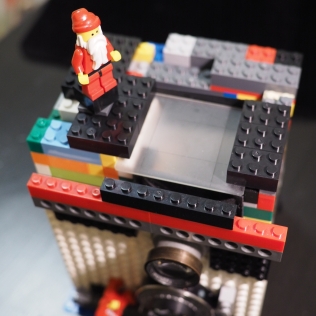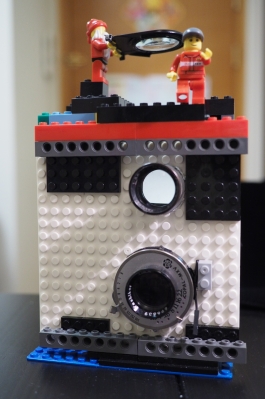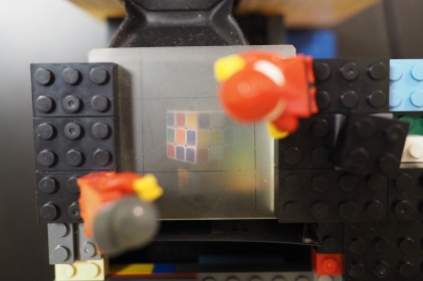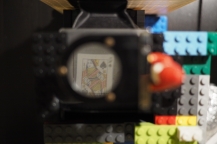Classic rendition
This is the world first Lego twin lens instant film camera – Lego Instant. Yes, I built this camera from scratch. I always have fascination in twin lens camera (TLR). The instant film adds the magic touch to this classic camera design.
First look at the Lego Instant

With my background on instant camera modification, it might be possible to build a Lego twin lens reflex with a classic design while using a modern Instax instant film. This camera is the first Lego camera to use instant film, as far as I know…
Looking from different perspective
Using the lens from the vintage camera
On the surface, it looks like a castle built with Lego. The design made reference to the classic twin lens film camera. Here I use two lens from a Japanese TLR – Yashica. I tried various ways to mount the lens onto the Lego tightly. The way I currently mount the lens preclude the use of glue.
Traditional twin lens reflex (TLR) – Yashica 635

Making use of Fuji Instax instant film
The film ejection mechanism is modified from a Fuji Instax Mini camera. Yes, the film ejection is driven by motor. Sounds cool? It uses Instax Mini film. Using instant film adds a new dimension to TLR. The classical TLR uses medium format film and it needs special processing to develop the pictures. And it takes a long time. Using Instax Mini film, I am always ready to give out the pictures to people. It is way more impressive than using a bulky-advanced camera and showing people the preview pictures on the small screen. It is an astounding and magical moment to witness an instant picture pops out from the Lego camera, not to mention the suspense of seeing the image emerges slowly.
Sample pictures
Camera construction process
Let me count how many bricks I have used later. Most of the bricks are ordinary bricks and a few Lego technic pieces were used in the front plane, which can be seen in the camera photo. I have this Lego TLR idea in my head for some months when I saw my neighbour throwing away boxes of Lego. I started to think about the possibility to modify a camera with Lego. My impression is there are always some creative way to use Lego; making a camera with it may not be entirely impossible. Weeks later I ordered lots of Lego and took me a night of experiment to come up with an initial skeleton design. But the method I mounted the lens was not satisfactory at the time, which was fragile and difficult to block out unwanted light. I tried to use the Lego software to design too but it is more difficult to visualise than to stack it physically.
Then I was trying to find some good Lego technic piece to resolve the mounting issue. Later I started to think it would probably be more efficient if I just drill the hole in a Lego flat plane. Everything went fast after that moment and I came up with a workable version which can take pictures.
Focusing mechanism – a ground glass locates on the top of the camera to assist focusing
Another focusing example
Greatest challenge is to block the light leak
To me, the challenge of using Lego as a camera, is always on how to block light leak. The previous two photographers who tried to build the camera have not resolved this problem fully. Lego, not only has lots of tiny gaps after assembling, it also turned half transparent if it is under strong light such as sunlight. There will be a lot of random light and colourful reflection on the picture if one only uses Lego to seal the film compartment. It needs to use some better approach to resolve this light leak completely, which I made use the traditional film camera modification techniques. I can take the camera out in a sunny day without any fear that the light will disturb the exposure, just as the sample pictures show.
Here are more pictures samples. Lens is a critical part of this project. The photo quality almost entirely depends on the lens, after we blocking all the random lights and reflections in the camera. Here again I use my favourite Yashica 80mm F3.5. It has a wide aperture and impressive bokhen. It is excellent as a walk around portrait lens and I also love its low light performances. Compared to the instant cameras in the market, the glass lens from Yashica delivers a much more stable performances in different lighting situations, a wider aperture to use, more appealing bokhen (while many instant cameras have no bokhen due to the small aperture) and richer and unique colour tone.
Many people asked about the size of the camera. Whether I can shrink it further and what’s the usage of different bricks. The answer is that not much room to shrink it further if we want to retain the twin lens design and a motorised film ejection system. The camera is quite comfortable to hold in hands. After carrying it around to shoot for a few weeks, the camera weight and size are manageable. It often creates some interesting emotion when people discovered this Lego castle is a camera. ddAnd even more surprise that it is not a commercial product but my own modification. They faint when they learnt that it is an instant camera. It is an absolute killer if they watch the magic performance after taking the pictures…
Stay tuned with us ! More topics about Lego Instant to be covered, including various tricks of using Lego Instant !
More updates on Lego Instant:
https://instaxmagic.wordpress.com/2016/12/25/enhancement-to-lego-instant-camera/
https://instaxmagic.wordpress.com/2017/01/10/lego-instant-camera-photo-collection/





















This is so, so brilliant I can’t stop smiling. Absolutely amazing! I want one!
LikeLike
Thanks Tom!
LikeLike
Oops! Entered my email and web address incorrectly the first time
LikeLike
Wonderful and fantastic! Happy that your dream come true. The resultant pictures are very nice.
LikeLike
Thanks Fred!
LikeLike
Amazing! Innovative idea with strong technical skills to build such an amazing camera!
LikeLike
Thanks. Hope to get more innovative ideas in the future. 😀
LikeLike
It’s amazing to witness its birth !!! Have been hearing & expecting ur magic!
It’s very much fansanated to know the details and rational behind this colorful castle, esp with Santa Claus being holding the lens in this festive season ! 🎅🏻 he def find the right chimney 🏡
LikeLike
👍 Santa Claus is important to this camera! How observant you are to note that. Will keep you posted on further upgrades 🙂
LikeLike
Incredible! Very creative in designing this and overcoming all the challenges in blocking unwanted light. Definitely not obvious that it’s a camera at first sight and quite impressed by the moment of magic produced as the film was ejected and developed. Excellent piece.
LikeLike
Yea, it is more like magic than a camera in some way.
LikeLike
Hi, I made instant TLR with early Ricohflex and Instax mini10 film system. Infinity is OK and can use TLR focusing system.
https://www.facebook.com/hashtag/チェキフレックス?source=feed_text&story_id=1329393597131332
LikeLike
Very nice Yohsuke. I like this!
LikeLike
Pingback: Lego Instant Camera Photo Collection | Instax Magic
I’ve been looking around for info and photos to do with the Instax ejection assembly. Might you have any? I want to undertake a modification of my medium format SLR Polaroid back as I can no longer easily or reliably obtain the larger, Polaroid style pack films. I was thinking of removing all or most of the internal components of the back to install the Instax hardware and mount an ejection button. What circuitry and components are required for just the ejection to remain powered and motorized? I’m starting to look for a camera to tear down, but I don’t have one yet and I was hoping to get insight from someone who has already done exactly what I’m hoping to do.
LikeLike